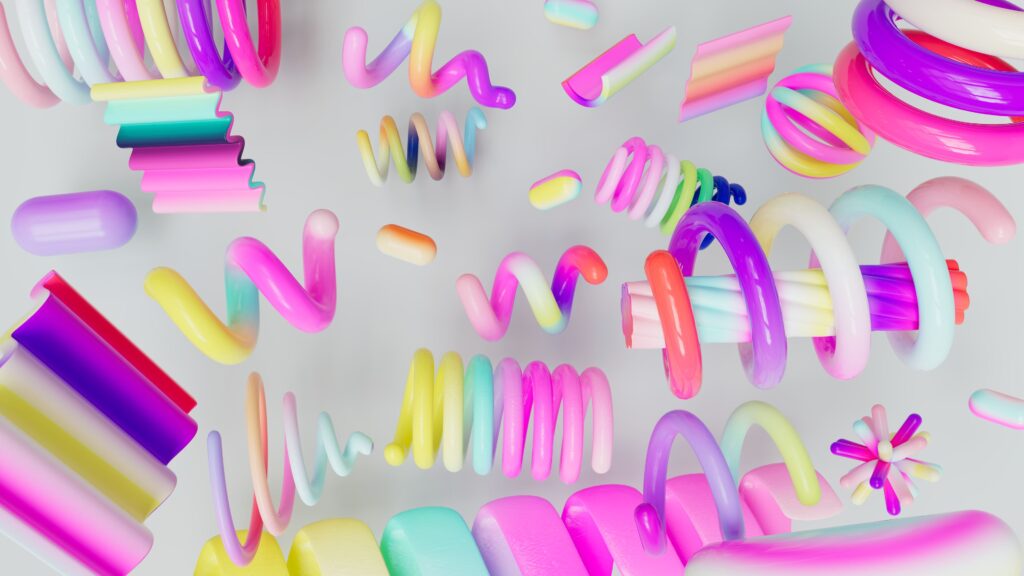Organic shapes, also known as biomorphic or curvilinear shapes, are irregular, free form shapes, and often asymmetrical forms that are reminiscent of objects found in nature. They contrast with shapes in geometry, which are typically precise, regular, and symmetrical.
What are Organic shapes?
Organic shapes refer to shapes that are irregular, free-flowing, and asymmetrical, resembling forms found in nature. They are often characterized by soft, curving lines and contours, lacking the precise angles and symmetry associated with geometric shapes.
They are inspired by various natural elements, such as plants, animals, bodies of water, or geological formations.
They can be found in various art forms, including paintings, sculptures, architecture, product design, and graphic design, providing a visually engaging and expressive element in creative expressions.

Art History of Organic Shapes
The use of organic shapes in art can be traced back to ancient times, with various cultures incorporating natural forms into their artistic expressions.
In prehistoric cave paintings and rock art, organic shapes were often used to depict animals, human figures, and natural scenes. Organic shapes were prevalent in ancient Egyptian, Greek, and Roman art. Greek and Roman sculptures incorporated organic shapes in the depiction of human figures and drapery curtains. They are also utilized by contemporary artists in various mediums.
Throughout art history, organic shapes have been used to convey a connection to nature, express emotions, and explore the beauty and complexity of the world. They have been employed in representational, decorative, and abstract art, showcasing their versatility and enduring appeal in artistic expressions across cultures and time periods.
Characteristics
Curves and Flow
Organic shapes are characterized by smooth, flowing lines and curves. They lack sharp angles or straight edges commonly found in geometric shapes. The curves in organic shapes often emulate the natural flow and movement found in the environment.
Irregularity
Unlike geometric shapes, which are precise and symmetrical, organic shapes tend to be irregular and asymmetrical. They may have variations in size, shape, and contour. This irregularity contributes to their natural and free-flowing appearance.
Natural Inspiration
Organic shapes draw inspiration from elements found in nature, such as plants, animals, water bodies, clouds, or human figures. They may resemble the shapes of leaves, flowers, shells, or other natural objects. This connection to the organic world gives them a sense of life and vitality.
Softness and Smoothness
Organic shapes often have a soft and smooth visual texture. The absence of sharp angles and straight lines contributes to their gentle and less rigid appearance. They can evoke a sense of comfort and relaxation.
Subjective Interpretation
Organic shapes leave room for subjective interpretation and personal connection. Due to their fluid and less defined nature, viewers may see different objects or images within the same organic shape. This ambiguity allows for individual perception and imagination.
Complexity and Intricacy
Organic shapes can range from simple and minimalistic forms to complex and intricate designs. They can contain multiple curves, twists, and turns, reflecting the intricate patterns found in nature. This complexity adds visual interest and depth to organic shapes.
Emotional and Expressive:
Organic shapes have the ability to convey emotion and mood. The flowing lines and natural references can evoke feelings of calmness, serenity, energy, or dynamism. They can also create a sense of movement and rhythm within a composition.
The characteristics of organic shapes reflect the beauty, complexity, and irregularity observed in the natural world. Their flowing lines, irregular contours, and subjective interpretations make them an engaging and expressive visual element.
Organic Shapes are derived from Nature
Organic shapes are derived from the natural world, taking inspiration from elements such as plants, animals, clouds, rocks, and human figures. They may resemble the shapes of leaves, flowers, waves, or animal forms. They can convey a sense of vitality, energy, and emotion.
They are often associated with life, growth, and natural rhythms. The absence of strict symmetry and order in organic shapes can create a feeling of dynamism and spontaneity.
Usage of Organic shapes
Organic shapes are frequently used in art, design, and architecture to evoke a sense of natural beauty, harmony, and fluidity.While organic shapes are often associated with natural forms, it is also possible to find man-made or human-created objects that incorporate organic shapes. It can be used in architectural designs such as in buildings with curvilinear facades, flowing rooflines.
It can also be used in furniture and product design.Organic shapes are also utilized in industrial design, particularly in the design of automobiles, consumer electronics, and household appliances. It can also be used in graphic design.

Man-made organic shapes often combine organic and geometric elements, blending natural forms with structured design principles to create visually captivating and functional objects.
Examples of Organic shapes
Free-form organic shapes are found in the natural environment and inspire graphic design. Incorporating these, some examples from our daily life are Leaves, Clouds, Ocean waves, flower petals, human figure, rocks and pebbles.

There are many natural organic shapes around us. There are also many abstract artworks that explore organic shapes, using flowing lines, curves, and irregular forms that evoke the essence of natural elements.
Psychological impact
Individual responses to organic shapes may vary, as psychological effects can be influenced by personal experiences, cultural backgrounds, and individual preferences. Nonetheless, the organic nature of these shapes often taps into our innate connection with the natural world and can have a positive impact on our well-being and emotional state.Here are some common psychological effects associated with organic shapes:
Calming and Soothing:
Organic shapes, with their flowing curves and gentle contours, can have a calming and soothing effect on people. They evoke a sense of natural harmony and relaxation, similar to the peacefulness found in natural environments. This can help reduce stress, anxiety, and promote a sense of tranquility.
Emotional Connection:
Organic shapes often resemble forms found in nature, such as plants, animals, or human figures. This association with living organisms can trigger emotional connections and evoke feelings of empathy, familiarity, and comfort. Organic shapes may tap into our innate affinity for the natural world, fostering a positive emotional response.
Approachability and Friendliness:
The lack of sharp angles and rigid lines in organic shapes can create a sense of approachability and friendliness. They have a softer and less imposing presence compared to geometric shapes, which can make them more inviting and welcoming. This characteristic is often utilized in design and branding to create a friendly and user-friendly aesthetic.
Playfulness and Creativity:
The irregularity and free-flowing nature of organic shapes can inspire a sense of playfulness and stimulate creativity. They offer a departure from strict order and structure, allowing for more imaginative and open-ended interpretations. This can encourage a sense of exploration and creative thinking.
Vitality and Energy:
Organic shapes, particularly those reminiscent of natural forms like flowing water or vibrant foliage, can convey a sense of vitality, energy, and dynamism. The curves and contours in organic shapes can create a perception of movement, evoking a feeling of life and vibrancy.
Relaxation and Stress Reduction:
Studies have shown that exposure to organic shapes, whether through visual art, natural landscapes, or design elements, can have a positive impact on stress reduction and relaxation. The gentle and flowing qualities of organic shapes can help promote a sense of well-being and mental rejuvenation.
Subjective interpretation
Unlike geometric shapes, which are more easily defined and recognized such as triangle or rectangle, organic shapes often leave room for subjective interpretation. Their flowing and irregular nature allows for a variety of visual associations and personal connections.
Organic shapes can be combined with geometric shapes to create visual contrast and balance. This juxtaposition or combining two contrasting characters can be seen in many designs, where the use of organic shapes adds a touch of softness and naturalness to an overall composition.
Organic Shapes in Art
Organic shapes in art are defined by flowing lines and contours. These lines can be smooth, curving, and irregular, emphasizing the natural and free-flowing nature of organic shapes. They often have three-dimensional qualities, conveying a sense of depth and volume. Artists use techniques such as shading, highlighting, and modeling to create the illusion of form within organic shapes.
Artists consider the balance and distribution of organic shapes to create a visually pleasing and harmonious composition. The choice of color and value (lightness and darkness) can greatly influence the interpretation and emotional impact of organic shapes in art. These were some of the elements of art used to enhance the organic shapes.
The interplay between line, form, composition, color, and other elements contributes to the overall impact and interpretation of organic shapes in art.
Conclusion
Organic shapes offer a departure from the rigidity and orderliness of geometric shapes, inviting a more fluid and intuitive aesthetic experience that resonates with the inherent beauty and complexity of nature. It can stimulate creativity, inspire a sense of vitality, and contribute to stress reduction and relaxation.
Whether used in art, design, or architecture, organic shapes provide a means to connect with our natural surroundings and evoke a wide range of emotions. They remind us of the beauty and complexity of the world around us, offering a visually appealing and psychologically impactful element in various creative endeavors.


Leave a Reply